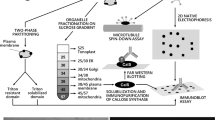Summary
The localization and orientation of cytoskeletal elements in developing cotton fibres were studied by the indirect immunofluorescence and the dry cleaving technique. Microtubules are transversely arranged to the cell axis, most probably in a flat helix, in the cortex of expanding fibres. Since the innermost deposited cellulose microfibrils always show primarily the same orientation it is postulated that the microtubules control the transverse deposition of the cellulose fibrils. Little further cell expansion takes place during secondary wall formation and the microfibril pattern corresponds to that of the cortical microtubules,e.g., in the steepness of their helicoidal turns. Microtubules with a length of 7–20 μm were observed, probably they are longer. The importance of microtubule length on microfibril deposition is discussed. The density of microtubule packing is in the range of 8–14 μm-1 as in other comparable cell types. In contrast to the microtubules, actin filaments are most likely longitudinally oriented during different phases of fibre development. The dry cleaving technique reveals numerous coated pits in the plasma membrane which are not crossed by microtubules. They seem to be linked to the latter by filamentous structures.
Similar content being viewed by others
References
Frey-Wyssling A (1976) The plant cell wall. In: Encyclopedia of plant anatomy, vol 3. Gebr. Bornträger, Berlin Stuttgart
Gunning BES, Hardham AR (1982) Microtubules. Ann Rev Plant Physiol 33: 651–698
Hardham AR, Gunning BES (1978) Structure of cortical microtubule arrays in plant cells. J Cell Biol 77: 14–34
Heath IB, Seagull RW (1982) Oriented cellulose fibrils and the cytoskeleton: A critical comparison of models. In:Lloyd CW (ed) The cytoskeleton in plant growth and development. Academic Press, London, pp 163–182
Herth W (1985) Plant cell wall formation. In:Robards AW (ed) Botanical microscopy 1985. Oxford University Press, Oxford
Itoh T (1974) Fine structure and formation of cell wall of developing cotton fiber. Wood Res 56: 49–61
Joachim S, Robinson DG (1984) Endocytosis of cationic ferritin by bean leaf protoplasts. Eur J Cell Biol 34: 212–216
Lloyd CW (1984) Toward a dynamic helical model for the influence of microtubules on wall patterns in plants. Int Rev Cytol 86: 1–51
—,Wells B (1985) Microtubules are at the tips of root hairs and form helical patterns corresponding to inner wall fibrils. J Cell Sci 75: 225–238
Meinert MC, Delmer DP (1977) Changes in biochemical composition of the cell wall of the cotton fiber during development. Plant Physiol 59: 1088–1097
Quader H (1986) Cellulose microfibril orientation inOocystis solitaria: proof that microtubules control the alignment of the terminal complexes. J Cell Sci 83: 223–234
— (1983) Morphology and movement of cellulose synthesizing (terminal) complexes inOocystis solitaria: evidence that microfibril assembly is the motive force. Eur J Cell Biol 32: 174–177
—,Deichgräber G, Schnepf E (1986) The cytoskeleton ofCobaea seed hairs: patterning during cell wall differentiation. Planta 168: 1–10
Robinson DG, Quader H (1982) The microtubule-micro fibrilsyndrome. In:Lloyd CW (ed) The cytoskeleton in plant growth and development. Academic Press, London, pp 109–126
Roelofson PA (1951) Orientation of cellulose fibrils in the cell wall of growing cotton hairs and its bearing on the physiology of cell wall growth. Biochim Biophys Acta 7: 45–53
Ryser U (1979) Cotton fiber differentiation: Occurence and distribution of coated and smooth vesicles during primary wall formation. Protoplasma 98: 223–239
— (1985) Cell wall biosynthesis in differentiating cotton fibres. Eur J Cell Biol 39: 236–256
Schnepf E, Roederer G, Herth W (1975) The formation of the fibrils in the lorica ofPoterioochromonas stipitata: Tip growth, kinetics, site, orientation. Planta 125: 45–62
— (1974) Microtubules and cell wall formation. Portugaliae Acta Biologica 14: No 1–2, 451–462
Seagull RW (1985) The effects of colchicine and taxol on microtubule arrays and cell wall deposition in developing cotton fibres: An immunofluorescence study. In:Robards AW (ed) Botanical microscopy 1985. Oxford University Press, Oxford
—,Heath IB (1980) The organization of cortical microtubule arrays in the radish root hair. Protoplasma 103: 212–218
—— (1979) The effects of tannic acid on thein vivo preservation of microfilaments. Eur J Cell Biol 20: 184–188
Simmonds D, Setterfield G, Brown DL (1983) Organization of microtubules in dividing and elongating cells ofVicia hajastana Gorsh. in suspension culture. Eur J Cell Biol 32: 59–66
Tanchak MA, Griffing CR, Mersey BG, Fowke LC (1984) Endocytosis of cationized ferritin by coated vesicles of soybean protoplasts. Planta 162: 481–486
Traas JA (1984) Visualization of the membrane bound cytoskeleton and coated pits of plant cells by means of dry cleaving. Protoplasma 119: 212–218
—,Braat P, Emons AMC, Meekes H, Derksen J (1985) Microtubules in root hairs. J Cell Sci 76: 303–320
Wiche G (1985) High-molecular-weight microtubule associated proteins (MAPs): a ubiquitous family of cytoskeletal connecting links. Trends Biochem Sci 10: 67–70
Wick SM, Seagull RW, Osborn M, Weber K, Gunning BES (1981) Immunofluorescence microscopy of organized microtubule arrays in structurally stabilized meristematic plant cells. J Cell Biol 89: 685–690
Wulf E, Deboben A, Bautz FA, Faulstich H, Wieland Th (1979) Fluorescent phallotoxin, a tool for the visualization of cellular actin. Proc Nat Acad Sci USA 76: 4498–4502
Yatsu LY (1983) Morphological and physical effects of colchicine treatment on cotton (Gossypium hirsutum) fibre. Textile Res 53: 515–519
—,Jacks TJ (1981) An ultrastructural study of the relationship between microtubules and microfibrils in cotton (Gossypium hirsutum L.) cell wall reversals. Am J Bot 68: 771–777
Author information
Authors and Affiliations
Rights and permissions
About this article
Cite this article
Quader, H., Herth, W., Ryser, U. et al. Cytoskeletal elements in cotton seed hair developmentin vitro: Their possible regulatory role in cell wall organization. Protoplasma 137, 56–62 (1987). https://doi.org/10.1007/BF01281176
Received:
Accepted:
Issue Date:
DOI: https://doi.org/10.1007/BF01281176




